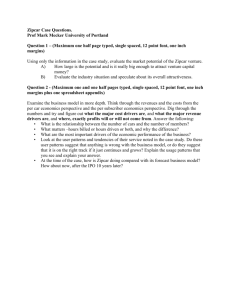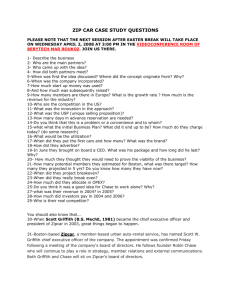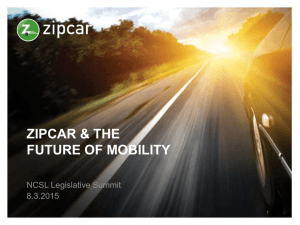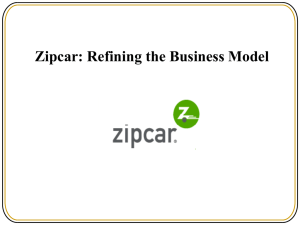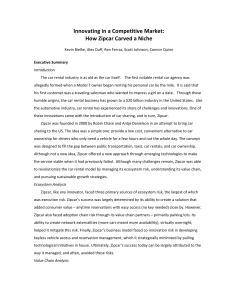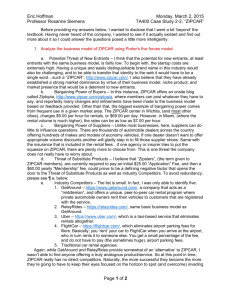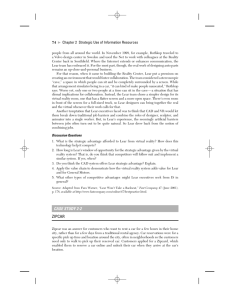Zipcar Business Plan Analysis
advertisement
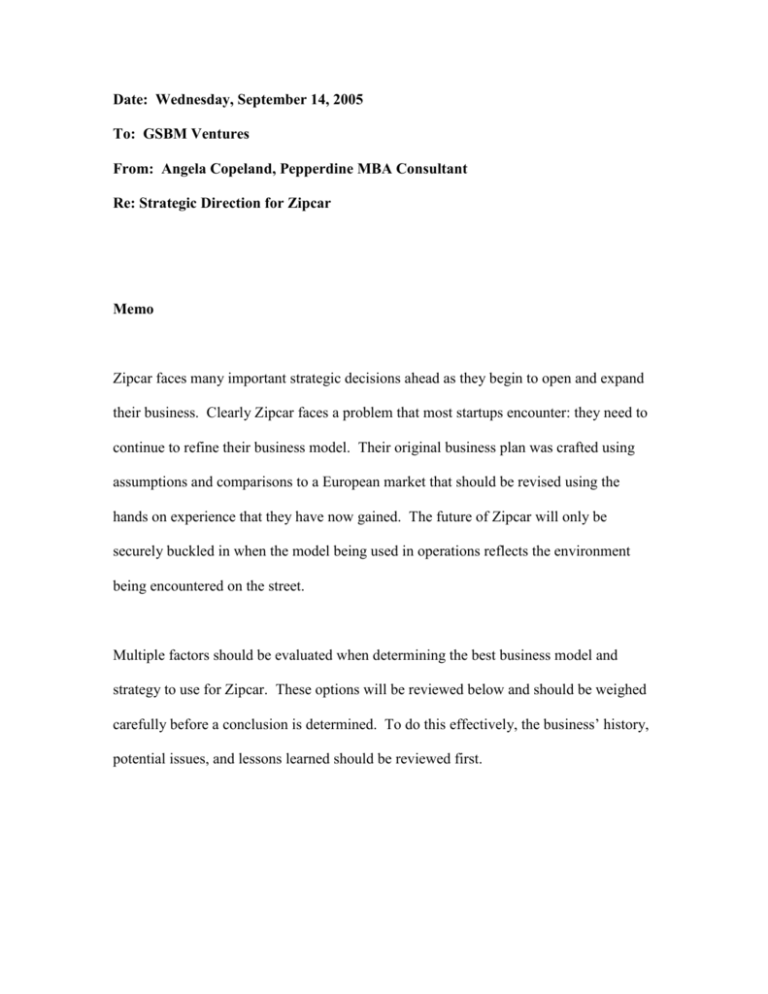
Date: Wednesday, September 14, 2005 To: GSBM Ventures From: Angela Copeland, Pepperdine MBA Consultant Re: Strategic Direction for Zipcar Memo Zipcar faces many important strategic decisions ahead as they begin to open and expand their business. Clearly Zipcar faces a problem that most startups encounter: they need to continue to refine their business model. Their original business plan was crafted using assumptions and comparisons to a European market that should be revised using the hands on experience that they have now gained. The future of Zipcar will only be securely buckled in when the model being used in operations reflects the environment being encountered on the street. Multiple factors should be evaluated when determining the best business model and strategy to use for Zipcar. These options will be reviewed below and should be weighed carefully before a conclusion is determined. To do this effectively, the business’ history, potential issues, and lessons learned should be reviewed first. Copeland Analysis 1: Zipcar History of Zipcar The idea for Zipcar began in 1999 when Antje Danielson approached Robin Chase with her new idea for a start up – car sharing. Danielson had observed the concept of car sharing on a vacation in Germany, which she noted was a trend throughout Europe. Chase agreed to partner with Danielson and they began to develop their business plan and to seek funding for it. Lessons Learned: One issue that Chase and Danielson faced from potential investors was the fact that neither of them had much real world experience in the automotive industry or with running a “complex operation.” They learned that the core team, in addition to the potential investors’ perception of that team, is key to getting support and in turn, funding for a new venture. Financing the Plan Eight months after first developing the idea for Zipcar, Chase began to rethink her business model. Through additional research, she learned that she would not be able to obtain free parking. She also learned that customers would not be willing to pay a high annual fee, but would be willing to pay more per hour. Last, she found that her vehicle costs would be higher than originally anticipated. Although Zipcar received multiple loans in the beginning, they struggled to find an additional $1.3 M in financing. Lessons Learned: While Zipcar offered a service that was previously almost non-existent in the U.S., the lack of focus on customer feedback prevented them from fully 2 Copeland Analysis 1: Zipcar understanding the public perception and therefore, the customer value of such a service. Multiple revenue streams are an important part of setting up a start up. They help to distribute risk more evenly, thus creating a more stable operation. Zipcar Technology In order to fully implement Zipcar’s vision and goals, its founders developed new technologies, which they intended to patent. Although this advanced system would have allowed the Zipcar model to integrate more seamlessly, the founders started the business without the initial technology in place. Lessons Learned: Technology that is not delivered on time does not help to accomplish the company’s goals. The patent pending technology is what allows Zipcar to operate in a customer-centric way, while keeping costs low. Although there is a desire to begin a new venture as quickly as possible, there are also many rewards for the company that does their homework. Customers would have had an overall more positive first impression of Zipcar if they had waited to launch until their technology was more solidly in place. Cost Drivers In order to create a convenient and easy to use service, Chase included gas, parking, insurance, and the car lease in Zipcar’s rental fee. These costs are mainly all variable and 3 Copeland Analysis 1: Zipcar all considered Zipcar’s cost drivers. As Chase developed the business model, she often had to adjust overall costs as she understood more about the cost drivers. Lessons learned: Cost drivers are an important part of the overall business model. It is very important that cost drivers are fully understood and that options are explored to help keep them as low as possible. The Founder Effect When a new venture is set in motion, the founding members have high expectations; however these often come with compromises. For example, the two founders of Zipcar declined to take a salary in its early years, but if these compromises are not made, the company would suffer. Although Danielson did come up with a strong business idea, she was not always prepared to make sacrifices in her work or personal life. Lessons Learned: In order to be successful navigators of a new business, each founder must agree to set the business as a top priority. As commitments within the business grow, new responsibilities may need to be defined. If not all parties can agree to meet their portion of the responsibilities, a renegotiation process must take place, so that everyone is in agreement and the best interest of the company are kept in mind. 4 Copeland Analysis 1: Zipcar Current Venture Status Working virtually by herself, Chase has made large strides to push the business forward. She has almost single handedly developed a business model, secured funding, and taken care of daily operations. With this in mind, Chase’s experience alone is not enough to bring this business to its full potential. To continue to expand the business, Chase should consider the following analysis. Operations and the Business Model The September actual operating data paints a detailed picture of the validity of the business model. Overall, the September operations have exceeded expectations, but there are multiple factors to consider that are described below. In addition, Figure 1 has been used to project Year 1’s operating data based on September’s actual operating data. There has been less attrition than originally projected. The original attrition estimate described in May was 15%, but September’s actual data showed this number to be less than 3%. The original estimate of the total number of members in Year 1 was 440. The new estimate (based on September data) shows that the actual number of members could have the potential to exceed 2,500. This would result in a membership rate of 650% of what was originally anticipated. The total number of trips that each member is taking per month is approximately 1/3 of that originally estimated. However, each individual trip is much longer in both time and miles. The number of miles per trip was estimated at 22, but the 5 Copeland Analysis 1: Zipcar actual number of miles per trip was approximately 49. The total number of hours per trip was estimated at 4, but the actual number of hours was 9.6. It is clear that although the business model did not fully anticipate every outcome that occurred, the venture was still very successful. All results exceeded the expectations originally set fourth in the initial estimates. 6 Copeland Analysis 1: Zipcar Overhead Expenses Boston Corporate 14,000.00 30,000.00 Year 1 (Based on Sept.) 168,000.00 360,000.00 141.00 112.00 105.00 101.00 3.00 239.00 5,088.00 2,800.00 7,575.00 1,512.00 1,692.00 1,344.00 1,260.00 1,212.00 36.00 2,868.00 61,056.00 33,600.00 90,900.00 18,144.00 Deposits Received in Sept Total at month end Ave deposit balance Interest earned on total deposits 42,300.00 71,700.00 42,090.00 155.00 507,600.00 860,400.00 505,080.00 1,860.00 Usage Available "car days" Trips taken (uses) hourly daily Total Miles Driven hourly daily Total Hours Used hourly daily Trips - nights & weekend % Hours of use - night and weekend % 439.00 335.00 218.00 117.00 16,339.00 5,341.00 10,998.00 3,223.00 1,351.00 1,872.00 60.00% 53.00% 5,268.00 4,020.00 2,616.00 1,404.00 196,068.00 64,092.00 131,976.00 38,676.00 16,212.00 22,464.00 720.00% 636.00% Revenues Total miles billed hourly daily Total hours billed hourly daily Total mileage revenue hourly daily Total hourly revenue daily hourly Total usage revenue daily hourly 5,765.00 5,341.00 424.00 2,287.00 1,351.00 936.00 2,276.00 2,106.40 169.60 12,368.50 7,220.50 5,148.00 14,644.50 5,317.60 9,326.90 69,180.00 64,092.00 5,088.00 27,444.00 16,212.00 11,232.00 27,312.00 25,276.80 2,035.20 148,422.00 86,646.00 61,776.00 175,734.00 63,811.20 111,922.80 Applications & Membership Beginning Memberships Applications Applications Approved New members Attrition Ending Members Total "Member Days" Application Fees Annual Member fees received annual member fees booked Sept. Figure 1: Projected year 1 operating data based on actual September operating data 7 Copeland Analysis 1: Zipcar Suggested Actions As a result of the September operating results described above, Chase has many important factors to consider in order to drive Zipcar into first place. Each must be carefully weighed, to understand which will most fully support the goals and the future of Zipcar. Critical success factors for Zipcar include: Acquisition and retention of knowledgeable leadership and staff Implementation of the developed Zipcar technology Ability to appeal to a financially savvy and environmentally conscious customer Options that Zipcar should consider in order to achieve these success factors include: Advisory Board: Create an increased knowledge base through the creation and development of an advisory board. Pricing Structure: Increase revenue by changing the pricing structure to reflect a customer that uses the cars less often, but for longer periods of time. Included would be an increase in the daily rental rate. In addition, the number of free miles should be reduced. As shown in Figure 2, a $44 price ceiling with 125 included free miles creates little incentive for the customer to use the car for only small increments of time – it is much cheaper for the customer (per hour) to borrow the car for 24 hours. 8 Copeland Analysis 1: Zipcar Per Hour # Hours Per Mile # Miles Price 5.5 1 0.4 125 55.5 5.5 2 0.4 125 61 5.5 4 0.4 125 72 5.5 6 0.4 125 83 5.5 8 0.4 125 94 5.5 10 0.4 125 105 5.5 12 0.4 125 116 5.5 14 0.4 125 127 5.5 16 0.4 125 138 5.5 18 0.4 125 149 5.5 20 0.4 125 160 5.5 22 0.4 125 171 5.5 24 0.4 125 182 Figure 2: This figure displays the theoretical price to use a Zipcar if there were no price ceiling, assuming a rate of $5.50 per hour and $.40 per mile for 125 miles (the number of free miles included with a 24 hour rental) Technology: Maximize the business by deploying Zipcar’s patent pending technology in its cars. This will increase communication and customer satisfaction. It will also keep the cost of operating Zipcar low. Revenue Sources: Minimize risk to Zipcar by continuing to pursue multiple revenue streams. In addition, focus on increasing this revenue quickly, to enable Zipcar to grow at a more rapid pace than originally anticipated. This revenue is especially needed to implement the technology described above. Cost Drivers: Understand Zipcar’s costs through the exploration of cost drivers such as gas, insurance, and parking. Then, research ways to reduce these cost drivers. Partnerships: Lower Zipcar’s cost drivers and increase their member base by utilizing partnerships. One example includes a partnership with specific parking companies in order to lower the overall cost of parking. Another partnership 9 Copeland Analysis 1: Zipcar example is to market toward universities, environmentally friendly groups, and young professional groups in order to increase overall membership and awareness. Customer Feedback: Utilize customer feedback to not only retain customers, but to continue to develop a strong brand and a strong business. Of all of these opportunities, the most important one for Zipcar to focus its energy on is the development of technology. In order to continue to grow the business at the rapid rate reflected in September, the technology piece must be implemented in the cars ASAP. In contrast, if Zipcar continues to use the hand written honors system that they launched with in September, they will have a higher rate of customer dissatisfaction, a decrease in company communications, and therefore an overall lower level of success. Key Opportunity Chase’s one key opportunity to ensure that Zipcar is a successful venture is to replace her co-founder. The company not only needs someone who is committed to the organization and will provide leadership and guidance, but also someone with more practical experience. Because Danielson developed the original idea for Zipcar, Chase should compensate her by buying out Danielson’s shares in the company. In her place, Chase should hire an experienced professional whose strengths complement those of Chase. For example, ideally she should consider an individual with superior leadership skills who has prior experience in automobile leasing and start ups. In order to attract someone of this caliber, Chase will need to offer them revenue sharing as part of their 10 Copeland Analysis 1: Zipcar overall compensation. In addition, Chase should be up front about her concerns such as keeping costs low and not wasting money on high priced items or meals. This will help Chase to not only avoid mistakes of the past, but to accelerate her to the finish line. 11
